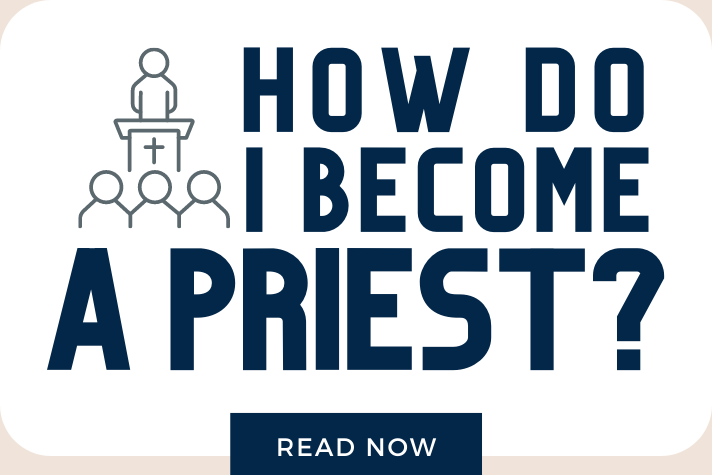How do I become a priest?
October 21, 2020

by Father Steven Huber, CSB
It seems that when a person is discerning the priesthood, one of the most common questions that is asked is “how long does it take to become a priest?” That question is often followed by another question: “what does the process of becoming a priest look like?” Since the answers to these questions go hand in hand, I want to do my best to answer both of them in one post.
On average, the formal formation for priesthood to the Congregation of St. Basil takes about eight years. There are some factors that can affect that length of time, but those are addressed as a candidate moves through each stage of the formation process.
The first stage of formation is for a candidate to spend time as a Basilian associate. This is the most flexible stage of the formation program. The amount of time that a person spends as an associate can be determined by many factors. For example, a person who enters the associate program immediately after graduating high school may spend as many as four years as an associate, while a person who enters after university may only spend a year or so.
The associate stage of formation has two phases, an informal phase when the candidate visits with the local Basilian community from time to time for community Eucharist and meals. In doing so, the associate gradually comes to know the local Basilian community. This informal phase is followed by a more formal period when the candidate is invited to live in a Basilian community and participate in the work of that community to the extent that he is able. This can include teaching in one of our high schools or another form of work that uses the candidate’s unique gifts and talents.
If during this more formal associate period the candidate feels called to continue to explore Basilian life, they can make an application for the novitiate. The novitiate lasts for one year and one day and marks a candidate’s formal entrance into religious life. It is a time when the candidate is asked to withdraw from the world and focus more intently on spiritual formation and prayer. The novitiate is sometimes referred to as a “spiritual boot camp,” which prepares the novice for his life as a member of the Basilian community.
After successful completion of the novitiate, the candidate will be invited to profess their first temporary vows of chastity, poverty, and obedience. These vows are taken for a period of three years. At that point, the candidate is considered a scholastic, and begins the program of study for priesthood in the seminary.
A candidate’s time as a scholastic can last anywhere from four to six years, depending on his educational background. Candidates will usually be asked to complete one to two years of studies in philosophy followed by four years of theology. If a candidate studied philosophy prior to entering the Congregation, he would likely begin his theological studies immediately after first profession.
While studying theology, a scholastic will study a wide range of topics and disciplines. These include moral theology, systematic theology, scripture, sacramental theology, and canon law. A scholastic will also be asked to complete several practical courses of study, including clinical pastoral education, where the candidate spends time working in a hospital. They will also learn how to properly celebrate the sacraments of the Church.
As a candidate nears the end of their seminary studies, they will be called to profess final—or perpetual—vows. These vows bind the individual to the Basilian community for life and signify that he is fully committed to living as a member of the Congregation.
Once a candidate has professed final vows and completed their seminary studies, he will be ordained to the diaconate. Ordination to the diaconate marks the last major step in formation before ordination to the priesthood. During his time as a deacon, a candidate will begin a time of supervised pastoral ministry, often in a parish. This period of supervised ministry continues into the candidate’s first year of priesthood.
At first glance, this whole process can seem daunting. But it’s important to remember that like most things in life, the path to becoming a priest is one that is traveled one step at a time. When you approach priestly formation in this way, it helps you to realize that the next step isn’t as big as you think. May God bless you as you continue to discern His will!
Categories
Discerning, a Vocations BlogGeneral News
Stirrings
Uncategorized
What’s seminarian life like?
by Father Eduardo Rivera, CSB “[The scholastic’s] preparation should include experience in all the elements of Basilian life and is intended to supply the member with resources for the life […]
Read MoreWho is called to become a priest?
by Father Jim Stenberg, CSB I was an adult convert to the Roman Catholic Church. I often tell people that religion is like a childhood illness; when you catch it […]
Read MoreI’m interested in Religious Life, what should I do?
by Father Steven Huber, CSB One of the questions that is often asked is what a person should do if they feel a calling to religious life. How does one […]
Read MoreWhat are the signs of a vocation to the priesthood?
by Father Steven Huber, CSB “How do I know if I am being called to priesthood or religious life?” This question is very common among discerners. The answer to this […]
Read MoreHow do we live the vow of chastity?
by Father Kevin Mannara, CSB Religious life involves living out our baptism in a more intentional and publicly prophetic way. That is why we take vows, including one to be […]
Read More